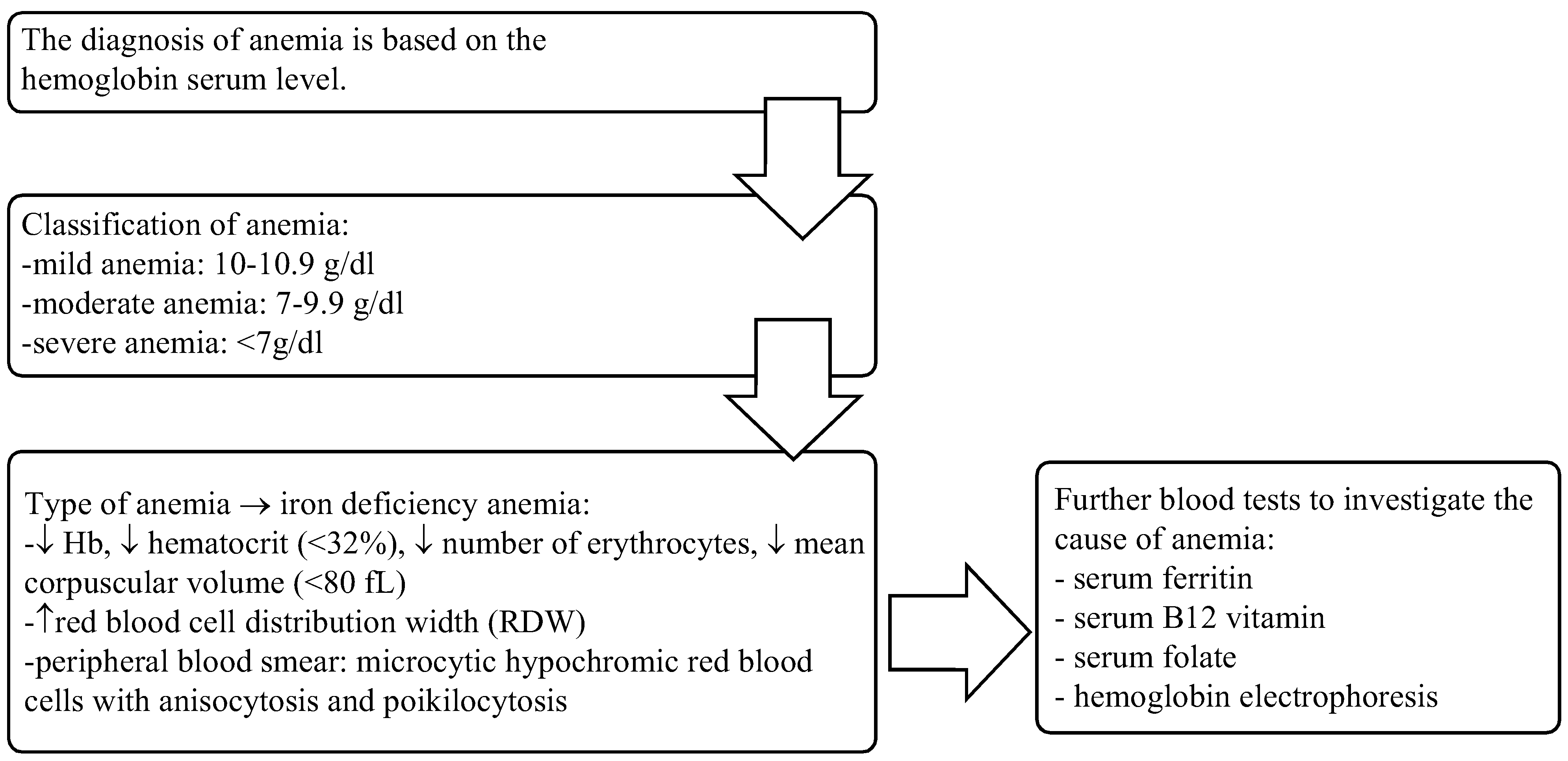Iron Supplementation in Pregnancy
Abstract
Introduction
Conclusion
References
- Anemia in Pregnancy: ACOG Practice Bulletin, Number 233. Obstet Gynecol. 2021, 138, e55–e64. [CrossRef]
- WHO. Anaemia. 2023. Available at https://www.who.int/news-room/fact-sheets/detail/anaemia.
- Stangret, A.; Skoda, M.; Wnuk, A.; Pyzlak, M.; Szukiewicz, D. Mild anemia during pregnancy upregulates placental vascularity development. Med Hypotheses 2017, 102, 37–40. [Google Scholar] [CrossRef] [PubMed]
- Means, R.T. Iron Deficiency and Iron Deficiency Anemia: Implications and Impact in Pregnancy, Fetal Development, and Early Childhood Parameters. Nutrients 2020, 12, 447. [Google Scholar] [CrossRef] [PubMed]
- Sifakis, S.; Pharmakides, G. Anemia in pregnancy. Ann N Y Acad Sci. 2000, 900, 125–136. [Google Scholar] [CrossRef] [PubMed]
- Chowdhury, S.; Rahman, M.; Moniruddin, A.B.M. Anemia in Pregnancy. Medicine Today. 2014, 26, 49–52. [Google Scholar] [CrossRef]
- Yokoi, K.; Konomi, A. Iron deficiency without anaemia is a potential cause of fatigue: meta-analyses of randomised controlled trials and cross-sectional studies. Br J Nutr. 2017, 117, 1422–1431. [Google Scholar] [CrossRef] [PubMed]
- Shi, H.; Chen, L.; Wang, Y.; Sun, M.; Guo, Y.; Ma, S.; Wang, X.; Jiang, H.; Wang, X.; Lu, J.; Ge, L.; Dong, S.; Zhuang, Y.; Zhao, Y.; Wei, Y.; Ma, X.; Qiao, J. Severity of Anemia During Pregnancy and Adverse Maternal and Fetal Outcomes. JAMA Netw Open. 2022, 5, e2147046. [Google Scholar] [CrossRef] [PubMed]
- Harrison, R.K.; Lauhon, S.R.; Colvin, Z.A.; McIntosh, J.J. Maternal anemia and severe maternal morbidity in a US cohort. Am J Obstet Gynecol MFM. 2021, 3, 100395. [Google Scholar] [CrossRef] [PubMed]
- Wiegersma, A.M.; Dalman, C.; Lee, B.K.; Karlsson, H.; Gardner, R.M. Association of Prenatal Maternal Anemia With Neurodevelopmental Disorders. JAMA Psychiatry. 2019, 76, 1294–1304. [Google Scholar] [CrossRef] [PubMed]
- Romanian Society of Obstetrics and Gynecology. Iron deficiency anemia in pregnancy national guideline. Availabe at https://sogr.ro/wp-content/uploads/2023/05/19.-Anemia-feripriva-la-gravida-revizuit-2023.pdf.
- Scholl, T.O. Maternal iron status: relation to fetal growth, length of gestation, and iron endowment of the neonate. Nutr Rev. 2011, 69 (Suppl 1), S23–S29. [Google Scholar] [CrossRef] [PubMed]
- Fleming, R.E.; Ponka, P. Iron overload in human disease. N Engl J Med. 2012, 366, 348–359. [Google Scholar] [CrossRef] [PubMed]
- Wang, W.; Knovich, M.A.; Coffman, L.G.; Torti, F.M.; Torti, S.V. Serum ferritin: Past, present and future. Biochim Biophys Acta. 2010, 1800, 760–769. [Google Scholar] [CrossRef]


| Anemic patients | Non-anemic patients at risk of iron depletion | Non-anemic patients who require an iron reserves estimation |
|---|---|---|
| Thalassemia Hemoglobinopathies At risk of multifactorial anemia (chronic pathologies) Patients requiring administration of parenteral iron | History of anemia, multiparity (>3 births), less than 1 year interval between pregnancies, first trimester hyperemesis gravidarum, twin pregnancy, haemorrhagic pathology in pregnancy, vaginal bleeding or other haemorrhages due to anticoagulant treatment History of malaria or parasitic infections Adolescents Vegan or vegetarian diet Diet deficient in foods that help iron absorption Tea, alcohol, coffee, chocolate consumption- ↓ iron absorption Digestive pathology with bleeding or occult bleeding: diverticulitis, haemorrhoids, cancer, bariatric surgery, Crohn’s disease, ulcero-hemorrhagic rectocolitis Recurrent infections | Patients refusing blood transfusions (for example patients belonging to certain religious groups) Patients at high risk of haemorrhage |
© 2023 by the author. The materials published in RJMP are protected by copyright. No part of this publication may be reproduced, copied or transmitted in any form or purpose. The manuscripts sent to the RJMP become the property of the publication and the authors declare on their own responsibility that the materials sent are original and have not been sent to other publishing houses.
Share and Cite
Salmen, B.-M.; Bohîlțea, R.-E. Iron Supplementation in Pregnancy. Rom. J. Prev. Med. 2023, 2, 26-30. https://doi.org/10.3390/rjpm2030026
Salmen B-M, Bohîlțea R-E. Iron Supplementation in Pregnancy. Romanian Journal of Preventive Medicine. 2023; 2(3):26-30. https://doi.org/10.3390/rjpm2030026
Chicago/Turabian StyleSalmen, Bianca-Margareta, and Roxana-Elena Bohîlțea. 2023. "Iron Supplementation in Pregnancy" Romanian Journal of Preventive Medicine 2, no. 3: 26-30. https://doi.org/10.3390/rjpm2030026
APA StyleSalmen, B.-M., & Bohîlțea, R.-E. (2023). Iron Supplementation in Pregnancy. Romanian Journal of Preventive Medicine, 2(3), 26-30. https://doi.org/10.3390/rjpm2030026



